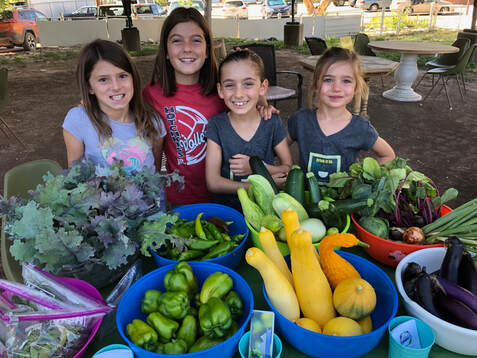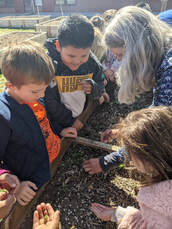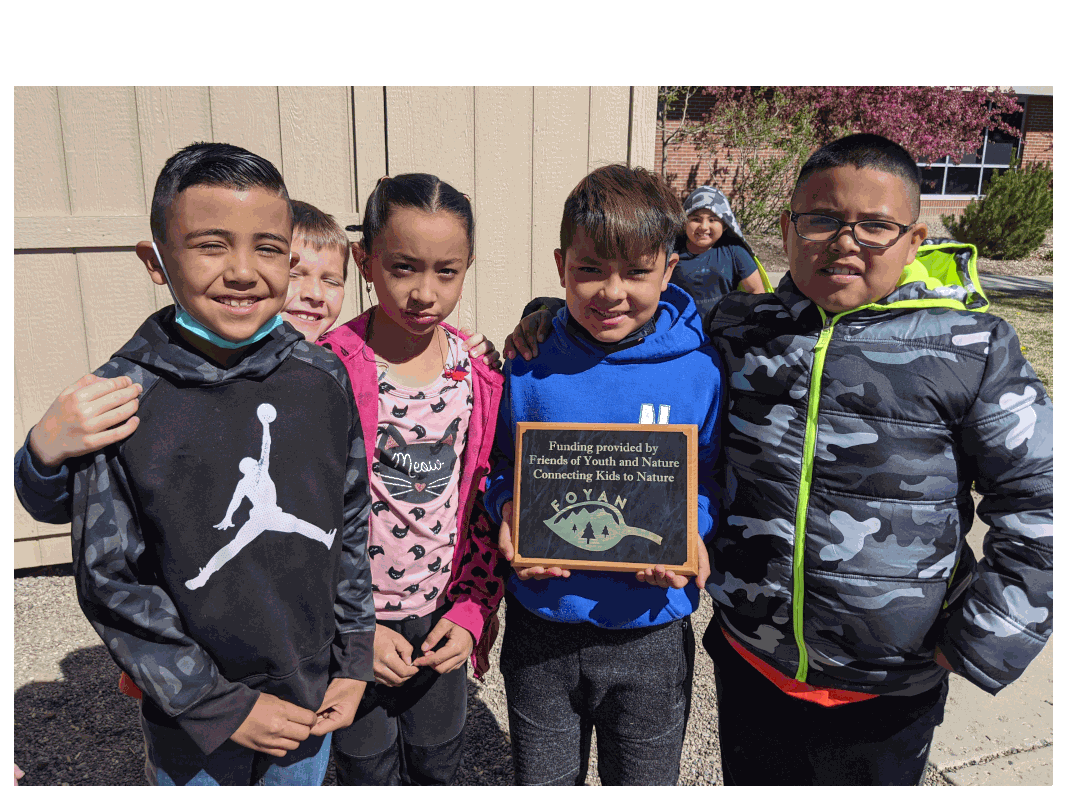|
Tips to help you connect your family to nature!
|
|
These young gardeners proudly display their tasty produce from the Hotchkiss K8 summer garden club (left: Ava Caldwell, Avery Flores, Anja Ullman, Whittier Ullman). (Photo credit: Angela Flores) Getting kids involved in growing their own food can be fun for both of you! What better way to teach kids about where their food comes from and the importance of healthy and local foods than growing your own at home? Watering, weeding, and caring for living things also teaches kids an important sense of personal responsibility, as well as patience.
Involve your kids in the entire process—start your garden planning early, and allow them to make the decisions (with a little guidance) so they feel ownership of the project. What kind of vegetables do they want to grow and eventually eat? If you’re using pots, help them research what size of pots those plants will need, and where in your yard to put them so they have the kind of sun or shade conditions they need to thrive. How often do you need to water, and whose responsibility will it be to make sure they’re getting enough water? How will you tell when they’re ready to eat? And, perhaps most importantly, let them plan out what you’re going to cook with each vegetable when they’re ready! There are many ways you can involve kids in garden planning and care, and they’ll learn a lot in the process. Here are a few quick and easy ways you and your kids can get started with a backyard garden. Building a garden bed can be time consuming, and it takes up a lot of space. If you’re not ready to take the leap to a full-on garden bed, potted plants can work well, too. There are a lot of vegetables that will grow in pots including tomatoes, beets, leafy greens like chard and kale, hot or sweet peppers, lettuces, onions, and even beans (as long as you have something for them to climb on). Just make sure the pots you use are big enough for the plants you want to grow—tomatoes, for instance, will need at least an 18-24” pot—and use a high quality potting soil that’s made for vegetables, so they’re getting all the nutrients they need. Sun-loving vegetables like tomatoes and peppers should be in a bright, sunny place, but make sure more delicate plants like lettuces and spinach have a little bit of shade to provide relief from the heat. Another easy way to bring the garden into your kitchen is with herbs. Not only will your kids get to participate in the growing process, but planning the meals you’ll make becomes even more fun! One idea is to start with some of your kids’ favorite foods, and ask them to help you research what herbs they’ll need to make it. Do they love lasagne or pizza? Oregano is critical to the Italian flavor. Are they big on pesto? Basil can be your crop of choice. Start with the final product, and work backwards to help them figure out what ingredient you’ll need to make it happen. Herbs are also great because almost all of them will thrive in small pots, which are convenient and can usually be grown indoors. You could do a number of different herbs—thyme, oregano, sage, rosemary, etc.—or just stick to one that requires a larger quantity, such as basil to be used in a batch of pesto. In addition, many of these herbs can continue to be grown in their pots indoors year round, providing fresh additions to your daily cooking beyond the normal summer garden. Your kids can help pick out or decorate fun pots, fill them with soil, start seeds or transplant already-started herbs, and pick out the spot where the plants will be happiest as they grow. Another good option to start with is lettuce. Lettuces thrive in cooler temps, like the early spring season or in the fall, and they’ll provide a continuing source of salads for your dining room table. They are easy to start from seeds, and there are many interesting and colorful varieties to choose from. Salad greens are a perfect farm to table connection—clip off some lettuce leaves, whip up a quick vinaigrette, and combine them into a fresh salad in less than 5 minutes. Lettuces have fairly shallow roots, so you can get away with a long and low container to house your whole lettuce garden. Have your kids help you pick out a variety of colorful and unique lettuces from the seed pack selection at your local nursery, fill your container with high quality soil, and plant rows of various lettuces to create a beautiful and tasty little crop of salad greens. Many businesses have stacks of pallets that they’re happy to get rid of—with a quick search on Craigslist you’ll be able to find a plethora of pallets, ripe for the picking. These pallets can be repurposed into a fun and economical vertical or horizontal garden with just a little work. This is a really neat way to create a space-saving and beautiful garden for a small backyard. There are hundreds of how-to guides for making a pallet garden that you can find online with a quick online search, but the basic process involves stapling landscape fabric inside the pallet to create multiple vertical rows for planting your vegetable garden. The main thing to be careful of in general, but especially with kids, is that pallets can have sharp nails and splinters, so be very conscious of that when you’re picking out pallets and building your garden. You can get your kids involved filling it with soil and planting all of the vegetables, or even a sweet treat like strawberries. You and your kids can also make an art project out of decorating the pallets with a bit of paint and creativity, to make a beautiful home for your small garden! With these simple ways to get a garden started with your kids, you’ll be able to teach them about their food and where it comes from, involve them in research and planning, and cultivate responsibility and patience. Have fun, and enjoy the fruits (or vegetables) of your labor!
4 Comments
“Who likes pickles?” asked Jan Congour, a second grade teacher at Northside Elementary. Her students gathered around the raised garden bed, each nibbling on a sprig of dill freshly emerged from the soil. This was the scene at morning recess, as the students learned about what herbs they like, and how to grow some of the things they like to eat in the 14 raised beds at the Northside Elementary Learning Garden.
The school’s garden project and outdoor classroom just got a $5,000 award to expand its outdoor learning space from Friends of Youth and Nature (FOYAN), a non-profit that promotes, supports, and facilitates opportunities for youth and their families to go outside, explore and embrace nature, and experience new activities in the outdoors. Funding of this award is partially from the El Pomar Foundation San Juan Regional Council and donations from supporters of FOYAN. El Pomar Foundation and FOYAN donors believe in the value, particularly now, of having access to experiences in our outdoor spaces that contribute to our youth’s well-being. The funding has been used to purchase and install a shed, so tools and supplies can be close to the garden area, hoop structures to extend the garden’s growing season, and materials to build compost bins. The funding has also been used to purchase shade sails, white boards, and seating for outdoor classroom areas. Student teams submitted designs for the outdoor classrooms to the school’s Garden Team for selection. The students were given a STEM challenge to design and help build compost bins. As part of the STEM challenge, the students researched the proper mix of greens and browns to put in the right stuff for a healthy, pest- proof compost that they will eventually work into the soil. The Learning Garden is a school-wide effort and has had four successful growing seasons. Each grade plants and maintains at least one garden bed with two to three vegetable varieties. Northside families, students, staff, and volunteers care for the garden in the summer. Each fall, the school hosts a harvest celebration where students and their families pick vegetables and learn more about the garden project. They also get to taste some of their rewards made into smoothies, juices, sautéed vegetables and snacks. This spring, second grade classes sold seed packets as a fundraiser to assist with the purchase of garden supplies. The seed packets were filled with seeds the second graders had harvested from the garden this past October. The Learning Garden provides an opportunity for the Northside teachers to incorporate conservation concepts such as helping students understand where the valley’s water supply comes from and watershed related issues. The students also learn about nutrition, recycling, composting, and how to minimize their carbon footprint. Congour believes that “kids can learn many intangible lessons from working in the garden such as cooperation, nurturing, problem solving, sustainability, and stewardship of the Earth.” One component of FOYAN’s mission is to promote healthy lifestyles. “The Northside school garden project is an excellent fit with FOYAN’s mission, particularly with the incorporation of the Live Well resources through Montrose Valley Food Partnership and nutrition lessons through the Denver Urban Garden Curriculum,” explained Anne Janik, FOYAN board member. Many community members are helping to make this garden project a success including seed donations from High Country Gardens and Valley Food Partnership and individual donations to FOYAN that are returned to the donor’s local community. But, the key to the Learning Garden’s success is the hard work of the Northside teachers, Garden Team, students, and families! Growing delicious food has already made an impact on these second graders! When the students were asked what their favorite vegetables were in the garden? “cilantro, tomatoes, and chilis“ were the winners! Getting kids involved in growing their own food is great for their education and development, and a ton of fun for both of you! What better way to teach kids about where their food comes from, and the importance of healthy and local foods than growing your own veggies at home? Having to water, weed and care for living things also conveys to your kids an important sense of personal responsibility.
You can bring your kids into the entire process—start your garden planning early, and allow your kids to make gardening choices (with your guidance) so they feel ownership of the project. What kind of vegetables do they want to grow and eventually eat? If you’re using pots, what size of pots will those plants need? Where in your yard should you put them so they have the kind of sun or shade conditions they need to thrive? How often do you need to water them, and whose responsibility will it be to make sure they’re getting enough water? How will you tell when they’re ready to eat? And, perhaps the most fun question, what are you going to cook with each vegetable when they’re ready? There are so many ways you can involve your kids in the garden planning and care, and they’ll learn a lot in the process. Here are 5 quick and easy ways you and your kids can get started with a backyard garden. 1 - Potted Plants Building a garden bed is time consuming and takes up a lot of space. If you’re not ready to take the leap to a full-on garden bed, potted plants can work just as well! There are a lot of vegetables that will grow in pots including tomatoes, beets, leafy greens like chard and kale, hot or sweet peppers, lettuces, onions, and even beans (as long as you have something for them to climb on). Just make sure the pots you use are big enough for the plants you want to grow—tomatoes, for instance, will need at least an 18-24” pot—and use a high quality potting soil that’s made for vegetables, so they’re getting all the nutrients they need. Sun-loving vegetables like tomatoes and peppers should be in a bright, sunny place, but make sure more delicate plants like lettuces and spinach have a little bit of shade to provide relief from the heat. 2 - Mini Herb Garden Another great way to bring the garden into your kitchen is with herbs. Not only will your kids get to participate in the growing process, but planning the meals you’ll make becomes even more fun! One idea is to start with some of your kids’ favorite foods, and ask them to help you research what herbs they’ll need to make it. Do they love lasagne or pizza? Oregano is critical to the Italian flavor. Are they big on pesto? Basil can be your crop of choice. Start with the final product, and work backwards to help them figure out what ingredient you’ll need to make it happen. Herbs are great because almost all of them will thrive in small pots, which are convenient and can usually be grown indoors. You could do a number of different herbs—thyme, oregano, sage, rosemary, etc.—or just stick to one that requires a larger amount, such as basil to be used in a batch of pesto. In addition, many of these herbs can continue to be grown in their pots indoors year round, providing fresh additions to your daily cooking beyond the normal summer garden. Your kids can help pick out or decorate fun pots, fill them with soil, start seeds or transplant already-started herbs, and pick out the spot where the plants will be happiest as they grow. 3 - Colorful Lettuce Garden Lettuces will thrive in cooler temps, like the current early spring season or in the fall, and they’ll provide a continuing source of salads for your dining room table. They are easy to start from seeds, and there are so many interesting and colorful varieties to choose from. Lettuces have fairly shallow roots, so you can get away with a long and low container to house your whole lettuce garden. Have your kids help you pick out a variety of colorful and unique lettuces from the seed pack selection at your local nursery, fill your container with high quality soil, and plant rows of various lettuces to create a beautiful and tasty little crop of salad greens. Salad greens are a perfect farm to table connection—clip off some lettuce leaves, whip up a quick vinaigrette, and combine them into a fresh salad in less than 5 minutes. 4 - Crop o’ Carrots Anybody who’s never had a carrot straight out of the garden is missing out. I still have vivid memories from when I was little, pulling fresh carrots straight out of my mom’s garden and washing off the soil with the garden hose for a quick summer snack. You’ll need a little deeper pot for carrots, since they’re a root vegetable, but about 12” of depth will be sufficient for your micro-crop of carrots. They’re incredibly easy to plant, just get some good soil and stick the seeds in the ground. One easy method of planting carrots and other small seeds is with a clean salt shaker; shaking the seeds from a salt shaker will help you to prevent over planting these tiny seeds. Before you know it, you’ll start seeing little carrot tops peeking their heads out above the soil. The only way to know whether they’re ready is by pulling one out, but of course, “ready” is a matter of opinion in this case. Tiny carrots are just as tasty as giant ones, and the longer you wait the more rewards you’ll reap—what a great way to teach kids the benefits of patience. 5- Pallet Garden This is a really neat way to create a space-saving and beautiful garden for a small backyard. Many businesses have stacks of pallets that they’re happy to get rid of—with a quick search on Craigslist you’ll be able to find many more pallets than you’ll ever need. These pallets can be repurposed into a fun and economical vertical or horizontal garden with just a little work. I won’t go into all the details of making a pallet garden, because there are hundreds of how-to guides you can find online with a quick Google search, but the basic process involves stapling landscape fabric inside the pallet to create multiple vertical rows for planting your vegetable garden. The main thing to be careful of in general, but especially with kids, is that pallets can have sharp nails and splinters, so be very conscious of that when you’re picking out pallets and building your garden. You can get your kids involved filling it with soil and planting all of the vegetables, or even a sweet treat like strawberries, and an especially fun thing you can do with them is paint and decorate the pallet to make it beautiful. So there you have it—5 quick and simple ways to get a garden started with your kids, and teach them about their food and where it comes from. Have fun, and enjoy the fruits (or vegetables) of your labor!
|
Blogs for Summer! DIY Summer Camps A Summer backyard Bucket List Hiking with Children 101 Kids, Dogs and Hikes a Winning Combination Getting Outdoors is Easier than You Think Categories
All
Archive
Archives
July 2024
|








 RSS Feed
RSS Feed


